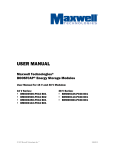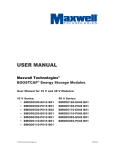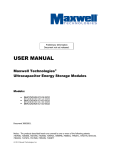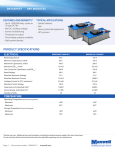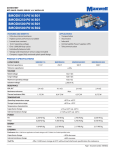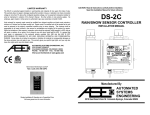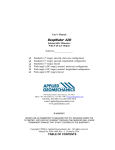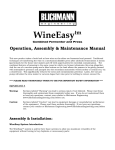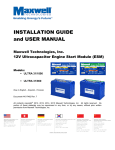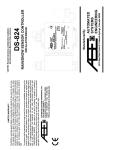Download USER MANUAL - Tecate Group
Transcript
USER MANUAL Maxwell Technologies® Ultracapacitor Energy Storage Modules Models: 16 V Series: BMOD0500 P016 B01 BMOD0500 P016 B02 BMOD0250 P016 B01 BMOD0110 P016 B01 48 V Series: BMOD0165 P048 B01 BMOD0110 P048 B01 BMOD0083 P048 B01 BMOD0165 P048 B06 Document 1008491 Notice: The products described herein are covered by one or more of the following patents: 7307830, 7203056, 7027290, 7352558, 7295423, 7090946, 7508651, 7492571, 7342770, 6643119, 7384433, 7147674, 7317609, 7495349, 7102877 © 2007-2011 Maxwell Technologies, Inc. 1. Introduction The 16 V and 48 V series energy storage modules are self-contained energy storage devices comprised of either six or eighteen individual ultracapacitor cells, respectively. The modules include bus bar connections and integrated cell balance voltage management circuitry. Units may be connected in series to obtain higher operating voltages, parallel to provide additional energy storage, or a combination of series/parallel arrangements for higher voltages and energy. Voltage management circuits function to protect each cell from operating in a damaging overvoltage condition. The module packaging (except for BMOD0110 P016) is a heavy-duty aluminum extruded enclosure. The enclosure is a sealed, water-resistant device (per IEC 529 – IP65). The package for the BMOD0110 P016 consists of a plastic housing with a metallic cover for thermal transfer. The voltage management electronics have a single open collector logic output (except for models with “B02” suffix) which indicates if any cell within the module is experiencing an over voltage condition. Each module contains one temperature monitor output in the form of an NTC thermistor. For models with a B01 or B06 suffix, please refer to document number 1011130 for details. B01 models have a nominal balance threshold of 2.8V while the B06 model has a nominal balance threshold of 2.6V. Each of these has an alarm circuit as described in paragraph 3.2.3. 2. Unpacking and Handling 2.1 Unpacking Inspect the shipping carton for signs of damage prior to unpacking the module. Damage to the shipping carton or module should be reported to the carrier immediately. Remove the module from the shipping carton and retain the shipping materials until the unit has been inspected and is determined to be operational. NOTE: The original shipping materials are approved for both air and ground shipment. The module should be removed from the shipping carton by lifting it by the module body and not by the terminal posts. The shipping container should contain the following: 1 x Energy Storage Module, part number determined by module type 1 x Accessory Kit If the unit is found to be defective or any parts are missing, contact your supplier. A Return Material Authorization (RMA) number must be issued prior to returning the unit for repair or replacement. 2.2 Handling Maxwell ultracapacitor modules are designed to provide years of trouble-free operation. Proper handling is required to avoid damage to module. In particular, the following handling precautions should be observed: User Manual – 16 V and 48 V Modules – Doc. No. 1008491.12 © 2007-2012 Maxwell Technologies, Inc. Page 1 • Do not stack modules once they have been removed from the shipping containers. • Do not drop modules. exterior. • Do not step on modules. • Protect the PCBA cover from impact. If any damage occurs to the PCBA cover, contact Maxwell for replacement instructions. • Do not use tools such as hammers to disengage mounting or terminal bolts. damage may occur. Internal damage may occur that will not be visible from the Serious 3. Installation 3.1 Mechanical Modules may be mounted and operated in any orientation. Two mounting surfaces are available (except for BMOD0110 P016); one at the top and the other at the bottom surface. These top and bottom plates are designed to support the module with no additional mechanical contact. See the data sheet for available mounting locations. The BMOD0110 models may only be mounted with the bottom side down to the mounting surface. For best results the modules should not be mounted in locations where they are directly exposed to the environment. In particular, areas of direct splash should always be avoided. In systems that operate at voltages in excess of 60 V, appropriate protection and sealing should be used on both module terminals to avoid shock hazards and corrosion. A proper installation should not exert any bending or twisting torque to the module enclosure. Ensure that the module’s mounting points are co-planar within ±1 mm. If the actual mounting location is out-of-plane, use spacers to bring all four mounting locations within plane to within ±1mm. Modules (except for BMOD0110 P016) have been qualified to SAE J2380 for vibration performance. Ensure that this is adequate for the end-use environment. If more severe vibration performance is required, consider the use of isolators to provide damping. Contact Maxwell Application Engineering for assistance in these cases. Each module is provided with an M5 threaded vent hole on the front panel. The module is shipped from the factory with a screw in this hole and the use of the hole as a vent is optional. The module is completely sealed, but if the application requires remote venting, an M5 threaded hose barb is provided in the accessory kit. Remove the screw which is in the hole when the module is received and replace it with the hose barb from that kit. Attach a 5/32 (4 mm) ID hose, preferably Teflon or polypropylene, to the hose barb and route the hose to a safe venting location. In the event of cell venting the cell may release gas which will build pressure in the module. That pressure can be relieved through the vent tube. User Manual – 16 V and 48 V Modules – Doc. No. 1008491.12 © 2007-2012 Maxwell Technologies, Inc. Page 2 3.2 Electrical WARNING CAUTION To avoid arcing the energy storage module should be in a discharged state and the system power disconnected during installation. The module is shipped discharged and with a shorting wire. The shorting wire should be removed prior to electrical connections. WARNING CAUTION To provide the lowest possible ESR the energy storage modules are not fused. Care should be taken within the application to prevent excessive current flow as required. Excessive current and/or duty cycle will result in overheating the module which will cause irreparable damage. Please consult the specific data sheet for each module for current and duty cycle capabilities. NOTE: The chassis of the module should be connected to system ground through any of the mounting holes with large enough gauge wire to carry the worst-case fault current. The anodized coating on the ground connection surface should be removed to ensure proper electrical contact. 3.2.1 Output Terminal Posts The output terminals of the module consist of internally threaded aluminum posts. They are designed to connect directly to a ring lug or a bus bar. Maximum thread depth is 16 mm. Maxwell-supplied bolts are also 16 mm in length. If ring terminals and lock washers in excess of 6 mm are to be used, a longer bolt must be selected. In no instance should the total amount of thread engagement be less than 10 or greater than 16 mm. The terminal contact surface should be cleaned with a light abrasive such as Scotch-BriteTM to remove any oxidation. Apply a layer of high conductivity anti-oxidant joint compound between the mating surfaces (IDEAL Noalox® Anti-Oxidant Compound or equivalent). The positive terminal is threaded for M8 x 1.25 steel bolts. The negative terminal is threaded for M10 x 1.5 steel bolts. Lock washers are required for long term, reliable connections. Star washers are the most effective lock washers, and split washers are not recommended. In no case should flat washers be used in User Manual – 16 V and 48 V Modules – Doc. No. 1008491.12 © 2007-2012 Maxwell Technologies, Inc. Page 3 addition to lock washers. For additional performance, a thread locking compound such as Loctite® 425 may be used. However, care should be taken that the thread locking compound does not come in contact with the electrical mating surfaces. When tightening the terminal bolts, a torque of 20 N-m / 14.8 ft-lbs for the M8 and 30 N-m / 22.1 ft-lbs for the M10 bolts should be used. Do not exceed recommended torque. As in any electrical system, proper cable dress is required for trouble-free operation. The cables used for attachment are large, and improperly constrained cables can place bending stress on the terminals and terminal bolts. Cables should be installed so that they do not exert bending or twisting torque on the power terminals, and should be routed away from the module so that they are parallel to the top surface of the terminal and constrained within 50 cm of the terminal before bending the cable in any direction. High vibration environments may require additional constraints. Attachment to the output terminals should be made with ring lugs or bus bars of an appropriate size for the application current. If bus bars are used, brackets should be installed to interconnect the tops of adjacent modules to prevent undesirable lateral forces on the terminals. The energy storage modules have low ESR. As a result, the resistance of the wires connecting the energy storage module to the application can easily exceed the ESR of the module. Connection of modules in series or parallel should utilize the same gauge wire (or equivalent bus bar) as determined for final output connections. When connecting in series connect the positive output terminal of one module to the negative output terminal of the next module. Two possible orientations are illustrated in Figure 1. Figure 1: Possible series connection arrangements User Manual – 16 V and 48 V Modules – Doc. No. 1008491.12 © 2007-2012 Maxwell Technologies, Inc. Page 4 Electrical isolation of the module is tested to 2500 VDC for a maximum allowable operating voltage of 750 VDC. Full UL810a compliance is satisfied for up to three (3) BMOD0165 P048 modules in series or nine (9) BMOD0500 P016 modules in series (maximum operating voltage of 150V). When several modules are connected in series for operating at higher voltage, care must be taken to ensure proper creepage and clearance distances in compliance with national safety standards for electrical equipment. 3.2.2 Module to Module Connections The 16V and 48V modules are equipped with the active voltage management circuit that protects and monitors every cell within the module. Module-to-module balancing is not required. Figure 2 – Series Connection of 48V Modules Figure 4 – Series Connection of 16V Modules Figure 3 – Parallel Connection of 48V Modules Figure 5 – Parallel Connection of 16V Modules NOTE: Although not depicted, modules BMOD0110 will follow similar connection schemes. User Manual – 16 V and 48 V Modules – Doc. No. 1008491.12 © 2007-2012 Maxwell Technologies, Inc. Page 5 3.2.3 Logic outputs A single open collector logic output is available for overvoltage monitoring. This output will indicate if any cell in the module has gone into an overvoltage condition. In addition, the output of the NTC thermistor is also available for module temperature monitoring. The overvoltage signal and temperature signal are available via the connector supplied with the module. Note: The passive version (suffix “B02”) of the BMOD0500 only provides the output of the NTC thermistor for the temperature monitor signal. There is no voltage monitoring signal in this module. The logic outputs are isolated from the capacitor voltages and from chassis ground. The logic outputs may be operated individually or wire-or’d to provide a single fault line. A table indicating the pin out, indication and maximum current is provided below. Pin # 1 2 Wire Color Black White 3 4 Red Green Pin out designation GRND Overvoltage Alarm Not used TEMP Output (16 V) Output (48 V) Maximum current High – Inactive Low - Active N/A High – Inactive Low - Active N/A 5 mA N/A NOTES: 1. Pin #2 is not used for the BMOD0500 P016 B02 model with passive balancing. 2. The Overvoltage Alarm will be asserted if any individual cell goes into an over voltage condition. The range of the alarm threshold is as follows: 2.73V minimum 2.80V nominal 2.86V maximum 3. The Overvoltage Alarm Signal (Pin 2) is an open collector output indicating when the voltage management electronics are active. In order to use the signal, the user must connect a pull-up resistor (≥1kΩ) between Pin 2 and a nominal 5V (maximum 5.5V) supply. In this configuration, the voltage at Pin 2 will be ~ 5V when the circuit is not active. When a cell in the module goes into an overvoltage condition, the output of Pin 2 goes low. The Overvoltage Alarm can be used as a signal to the system electronics to stop charging in order to protect cells from damage. When an acceptable cell voltage is reached, the output goes high again and can be used as a signal to resume charging. Figure 6 shows a typical connection to use this system. 4. The Overvoltage Alarm circuit can sink up to 5 mA with a VOL of no more than 0.4V. The leakage current when the output is off is 50 nA. The proper value of the pull-up resistor should be calculated based upon overall system circuit design. User Manual – 16 V and 48 V Modules – Doc. No. 1008491.12 © 2007-2012 Maxwell Technologies, Inc. Page 6 Fig. 6 – Typical connection to the monitor cable. (Users to verify values based on their circuit design) The temperature output operates at any module voltage including zero volts. The TEMP output is via a NTC thermistor and can be measured between pin 4 and pin 1 (GND) of the connector. The resistance of the thermistor varies with temperature to provide the actual temperature of the module. The thermistor is located in the center of the module. Under normal operating conditions the temperature output should represent the module’s hottest location. The resistance measured through the thermistor relates to temperature according to a US Sensor thermistor with a nominal value of 10KΩ @ 25ºC (reference temperature chart for the 103JM1A.) http://www.ussensor.com/rt charts/103JM1A.htm A mating connector for these signals is provided with 6” (15 cm) of cable length. Additional 22 gauge wire may be spliced for longer wire length up to 6 feet (1.8 m). For lengths longer than 6 feet (1.8 m) shielded 4 conductor wire is recommended. 3.3 Thermal Performance Low internal resistance of the energy storage modules enables low heat generation within the modules during use. As with any electronic component, the cooler the part operates the longer the service life. In most applications natural air convection should provide adequate cooling. In severe applications requiring maximum service life, forced airflow or a liquid-cooled cold plate may be required. The thermal resistance, Rth, of the units has been experimentally determined assuming free convection at ambient temperature (~ 25oC). The RTH value provided on the datasheet is useful for determining the operating limits for the units. Using the Rth value a module temperature rise can be determined based upon any current and duty cycle. The temperature rise can be expressed by the following equation. ∆T = I 2 RESR RTH d f where: I = RMS current (amps) RESR = equivalent series resistance, RDC (ohms) RTH = thermal resistance (oC/W) df = duty cycle fraction The ∆T value calculated above plus ambient temperature should remain below the specified maximum operating temperature for the module (please refer to the module datasheet) as measured by the thermistor output. If active cooling methods are employed, it is possible to operate at higher currents or duty cycles than if only passive cooling is utilized. User Manual – 16 V and 48 V Modules – Doc. No. 1008491.12 © 2007-2012 Maxwell Technologies, Inc. Page 7 4. Accessories The following accessories are provided with modules within the accessory kit. 1 1 1 1 1 x Users Manual Deutsch 4 pin connector. Used for Overvoltage output and temperature monitoring x Hex head cap, M10x16, Zinc plated screw x Hex head cap, M8x16, Zinc plated screw x SRTG6 – Misumi, Barbed coupler. Optional item providing venting capability. 5. Operation The module should only be operated within specified voltage and temperature ratings. Determine whether current limiting is necessary based on the current ratings of attached components. Observe polarity indicated on module. Do not reverse polarity. 6. Safety WARNING DANGER – HIGH VOLTAGE HAZARD! Never touch the power terminals as the module can be charged and cause fatal electrical shocks. Always check that the module is fully discharged before manipulating the module. Please refer to the step by step instructions below for the manual discharge procedure. • • • • • • Do not operate unit above the specified voltage. Do not operate unit above the specified temperature rating. Do not touch terminals with conductors while charged. Serious burns, shock, or material fusing may occur. Protect surrounding electrical components from incidental contact. Provide sufficient electrical isolation when working above 50 V DC. Prior to installation on or removal from the system, it is mandatory to fully discharge the module to guarantee the safety of the personnel. User Manual – 16 V and 48 V Modules – Doc. No. 1008491.12 © 2007-2012 Maxwell Technologies, Inc. Page 8 WARNING A fully discharged module may “bounce back” if it is stored without a shorting wire connected to the + and – terminals. This bounce back can be as much as 6V for the 48V module and is enough to cause dangerous electrical shocks. 6.1 Discharge Procedure Proceed as follows to discharge the module: 1. Using a voltmeter, measure the voltage between the 2 terminals. 2. If the voltage is above 2V, a resistor pack (not supplied with the module) will need to be connected between the terminals. Proper care needs to be taken in the design and construction of such a dissipative pack. e.g. At 48V, for a 4 Ohm pack, the module will be discharged with a peak current of 12 A and will take about 30 minutes to reach a safe voltage. However, in this case, the peak heat/power dissipated in the resistor pack will be ~ 600 W. The resistor pack will need to be sized and provided with suitable cooling to handle this power dissipation. Additionally, proper enclosure or other packaging is necessary to ensure safety. In all cases, proper design of the dissipative resistor pack is necessary. 3. If the voltage is under 2V, connect the shorting wire provided by Maxwell to the + and – connectors. 4. The module is now safe for handling. However, leave the shorting wire connected at all times until the module is installed in the system and the power cables are connected. 7. Maintenance Prior to removal from the system, cable removal, or any other handling ensure that the energy storage module is completely discharged in a safe manner. The stored energy and the voltage levels may be lethal if mishandling occurs. Maintenance should only be conducted by trained personnel on discharged modules (see above). 7.1 Routine Maintenance 7.1.1 Clean exterior surface of dirt/grime 7.1.1.1 Reason - Improve power dissipation performance. 7.1.1.2 Use a cleaning cloth dampened with a water/soap solution. Do not use high-pressure sprays or immersion. Keep excess amounts of water away from the PCBA cover and power terminals. 7.1.1.3 Frequency 7.1.1.3.1 Outside use (6 months, or as needed) 7.1.1.3.2 Inside use (annually) User Manual – 16 V and 48 V Modules – Doc. No. 1008491.12 © 2007-2012 Maxwell Technologies, Inc. Page 9 7.1.2 Check mounting fasteners for proper torque 7.1.2.1 Reason - Avoid mechanical damage 7.1.2.2 Frequency 7.1.2.2.1 High Vibration Environments (6 months) 7.1.2.2.2 Low Vibration Environments (12 months) 7.1.3 Inspect housing for signs of damage 7.1.3.1 Reason – allows potential internal damage to be identified 7.1.3.2 Frequency 7.1.3.2.1 Outside use (6 months, or as needed) 7.1.3.2.2 Inside use (annually) 7.1.4 Check signal/ground connections 7.1.4.1 Reason – avoid false signals or shock hazards 7.1.4.2 Frequency 7.1.4.2.1 High Vibration Environments (6 months) 7.1.4.2.2 Low Vibration Environments (12 months) 8. Storage The discharged module can be stored in the original package in a dry place. Discharge a used module prior to stock or shipment. A shorting wire across the terminals is strongly recommended to maintain a short circuit after having discharged the module. 9. Disposal Do not dispose of module in trash. Dispose of according to local regulations. 10. Specifications Refer to datasheets at our website, www.maxwell.com, for specifications for each specific product. User Manual – 16 V and 48 V Modules – Doc. No. 1008491.12 © 2007-2012 Maxwell Technologies, Inc. Page 10 Maxwell Technologies, Inc. Worldwide Headquarters 5271 Viewridge Court, #100 San Diego, CA 92123 USA Phone: +1 858 503 3300 Fax: +1 858 503 3301 Maxwell Technologies SA CH-1728 Rossens Switzerland Phone: +41 (0)26 411 85 00 Fax: +41 (0)26 411 85 05 Maxwell Technologies GmbH Brucker Strasse 21 D-82205 Gilching Germany Phone: +49 (0)8105 24 16 10 Fax: +49 (0)8105 24 16 19 [email protected] – www.maxwell.com Maxwell Technologies, Inc. Shanghai Representative Office Unit A2,B,C 12th Floor, Huarun Times Square 500 Zhangyang Road, Pudong New Area, Shanghai 200122, P.R. China Tel: +86 (0)21 3852 4016 Fax: +86 (0)21 3852 4099













